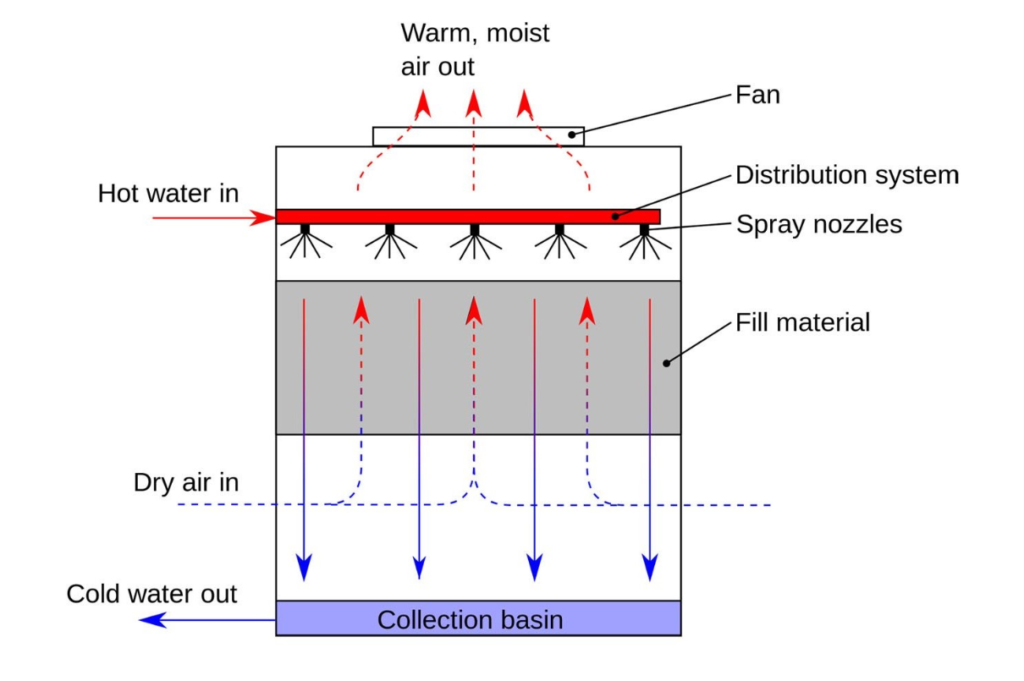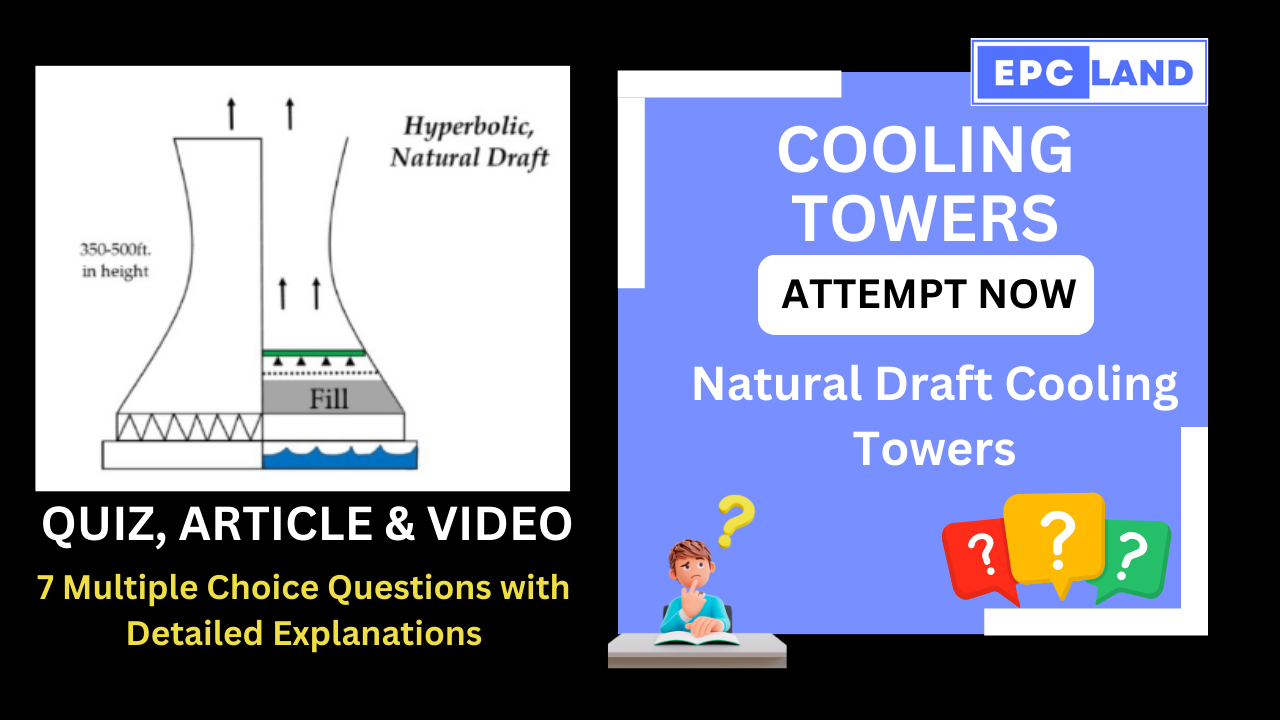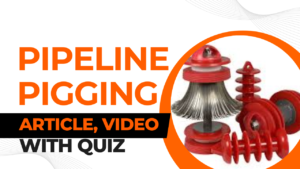

1. Type of Cooling Tower
What type of cooling towers are typically used for large-scale applications like power plants?
Explanation: Natural Draft Cooling Towers are typically used for large-scale applications like power plants due to their reliance on natural convection.
2. Operating Principle
How do Natural Draft Cooling Towers create a continuous cooling cycle?
Explanation: Natural Draft Cooling Towers create a continuous cooling cycle by relying on natural convection, where hot air rises and cooler air is drawn in at the bottom.
3. Advantages of Natural Draft Cooling Towers
What is an advantage of Natural Draft Cooling Towers?
Explanation: An advantage of Natural Draft Cooling Towers is their simple design and construction, leading to lower operating costs.
4. Disadvantages of Natural Draft Cooling Towers
What is a disadvantage of Natural Draft Cooling Towers?
Explanation: A disadvantage of Natural Draft Cooling Towers is their limited cooling capacity compared to mechanical draft towers.
5. Weather Susceptibility
What weather conditions can Natural Draft Cooling Towers be susceptible to?
Explanation: Natural Draft Cooling Towers can be susceptible to weather conditions such as wind and temperature.
6. Natural Draft Cooling Tower Design
Why do Natural Draft Cooling Towers require a large footprint?
Explanation: Natural Draft Cooling Towers require a large footprint due to their tall hyperbolic shape, which facilitates natural convection.
7. Cooling Tower Classification
How are cooling towers classified based on the draft and the direction of airflow?
Explanation: Cooling towers are classified based on the draft and the direction of airflow they utilize during the cooling process.
Don’t miss the following related topics on Cooling Towers
Short Article on Natural Draft Cooling Towers
Cooling towers are often the unsung heroes of industrial processes. These tall, open-topped structures play a vital role in keeping industrial processes and HVAC systems running smoothly. They work by cooling water that has been heated up during industrial operations or in buildings.
There are two main types of cooling towers, classified by the draft and the direction of airflow:
Natural Draft Cooling Towers:
These towers are typically used for large-scale applications like power plants and industries with high cooling water flow rates.
They operate by relying on natural convection, where hot air rises and is released into the atmosphere through the tower’s tall, hyperbolic shape. This natural draft draws in cooler air at the bottom of the tower, creating a continuous cooling cycle.
Advantages:
- Simple design and construction.
- No need for additional fans.
- Lower operating costs.
Disadvantages:
- Requires a large footprint due to their height.
- Limited cooling capacity compared to mechanical draft towers.
- Susceptible to weather conditions like wind and temperature.
Table of Contents
Don’t miss the Course on Effective Isometrics Management: Check Now
Enrollment Link
Recommended courses (Published on EPCLand)
- Complete Course on Piping Engineering
- Basics of Piping Engineering
- Piping Layout Engineering
- Piping Material Engineering
- Piping Stress Analysis
- Material Requisitions
- Piping Material Specifications
- Valve Material Specifications
- Plant Design & Layouts-OISD 118
- Isometric Management
Library of Technical Articles
Don’t miss out the collection of 15+ articles on following topics:
- Basics of Oil and Gas Industry
- Valves
- Testing
- Tank
- Piping Bulk Items
- Pipe
- Metallurgy
- Piping Materials
- Layout
- Instrumentation
- Heat Exchanger
- Type of Contracts
- Codes and Standards
- ASTM Standards
- Articles on Piping Specialty Items
Video details of Complete Course on Piping Engineering
Why Enroll in the EPCLand
Proven Track Record– PTR
Activities & Achievements before launching EPCLand
- Published more than 50+ short courses
- 3000+ Enrolments
- More than 3,500,00 Minutes of watch hours in the last 2 years
- 4000+ Students in 100+ Countries
- Rating of 4+ out of 5
- 1000+ YouTube Videos
- 8K+ Subscribers
What Students will Learn
- Codes & Standards of the Energy Sector
- Piping Material Engineering
- Piping Layout Engineering
- Stress Analysis
Interesting facts
- All the published courses have been developed by Industry Experts with more than 2 decades of experience
- Content is based on Practical experience and real-time problems.
- Content is designed and organized in such a manner that it can be easily grabbed.
- Complete website, Blogs and Quiz sections are Planned, Designed and published by myself (About me: Atul Singla)
- Complete flexibility of Time & Location, Students can access the content from anywhere & anytime
- Moreover, once enrolled, the content can be access as many times as you want, which helps in understand the fundamentals in a better way.
Conclusion
In conclusion, our courses are meticulously crafted by industry experts with over two decades of hands-on experience. The content is rooted in practical knowledge, addressing real-time problems. The material is thoughtfully designed and organized for easy comprehension. Every aspect, from the website to blogs and quizzes, has been planned, designed, and executed by Atul Singla, ensuring a comprehensive and seamless learning experience. With the flexibility of accessing the content at any time and from any location, students have the freedom to learn on their terms. Furthermore, enrollment grants unlimited access, allowing learners to revisit the material as often as needed, fostering a deep understanding of the fundamentals.



